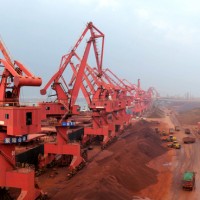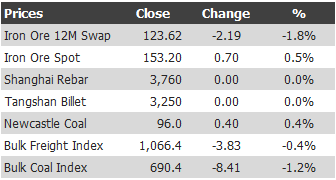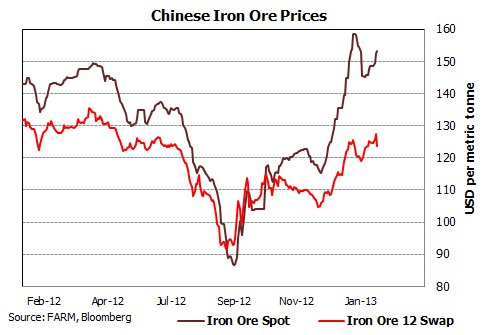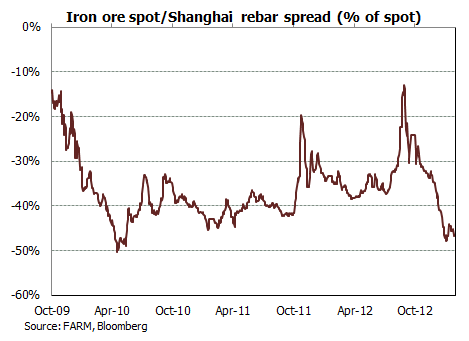
Here is the iron ore price table for February 1, 2013:

And chart:

So, no sooner have swaps broken out than they’ve scuttled back under cover. No movement in Chinese steel prices. But the futures market was different with rebar futures piling it on again:

My spread charts still look seriously sick. Spot to swap is going wide again:

And spot to rebar is threatening even more perverse levels:

Chinese stockpile data is yet to be updated for the week.
Business Standard has an interesting take on the state of play as Indian ore wrestles with its socialists:
Also, the government suddenly woke up to preserve the national resource for use in the domestic market. This led to the tracking of illegal miners and exporters in the three leading producing states — Karnataka, Goa and Odisha. While mining activity in Karnataka came to a standstill two years ago following the Supreme Court order to crack the whip on illegal mining, cancellation of environment clearance and non-renewal of the expired ones prevented mining in over 100 mines in Goa, which contributed around 50 per cent of iron ore exports in 2009-10. The Supreme Court-appointed M B Shah Commission recommended stay on mining in a number of mines in Odisha resulting in lower domestic production and exports.
OreTeam Exim, a Delhi-based research firm, forecasts India’s iron ore exports at 18 million tonnes in 2012-13 due to various issues surrounding mining and trading activities for the last two years in Karnataka, Odisha, Chhattisgarh and Goa, which squeezed exports, virtually killing the business of 90 per cent of the trading community who were relying on exports.
Looking ahead, global miners and experts say 2013 could be the penultimate year for iron ore exports to see average price levels of $140 per tonne CFR. In the next two years, it could slip to $120 a tonne CFR China as supply overtakes demand creating a lull in prices. On the other hand, for Indian traders and miners, the export market would be favourable only if the levels are above $130 a tonne CFR. Hence, beyond 2013-14, there is a huge possibility that the iron ore market could head downwards in terms of spot market prices, virtually closing the doors for Indian suppliers (if freight and export duty remain unchanged), said an analyst at OreTeam.
India is a relatively low cost producer, $55 per tonne or so, so that gives you an idea of how onerous the new regime of controls is. If India returns the pressure on prices will be pretty nasty. If not, it’ll help for this year.
Meanwhile, Chinese socialists are building railways to nowhere. From the China Times:
The construction of high-speed railways can promote local economic development and will be the lifeline for Chinese steel makers, said Wang Mengshu, an academician at the Chinese Academy of Engineering.
Thousands of factories, including steel makers, appealed to the State Council to restart railway projects halted after the Ningbo-Taizhou-Wenzhou rail accident in July 2011, leaving 39 passengers dead and more than 100 passengers injured. Anshan Iron and Steel Group, one of the factories, said steel companies will be forced to shut down if the government continues to halt railway construction.
Some leaders of local governments reportedly went to Ministry of Railways to negotiate the projects at the end of last year.
…High-speed rail construction has become an important investment to boost local economies, said an anonymous expert of China Railway Electrification Bureau. Many local governments have showed their interest in supporting projects because the Ministry of Railways has to handle the construction costs and provide compensation for demolishing houses, said an expert.
China completed 11 new high speed railway projects in 2012, ranking first in the world for laying 9,356km of lines. The total length, including existing railways, is expected to reach more than 16,000 kilometers in 2020, covering 90% of populated areas.
The great majority of China’s train travelers are students and migrant workers who can’t afford to pay for high-speed rail. Maybe one day.
Australian iron ore is built on socialist misadventure.

